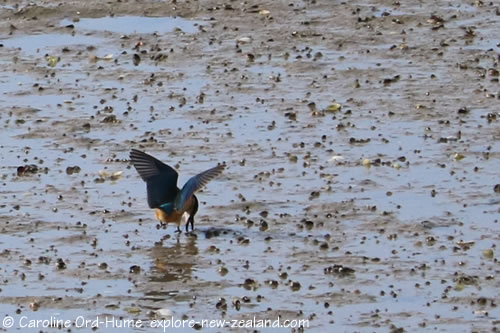New Zealand Sacred Kingfisher
It is said that Sacred Kingfisher birds have been called ‘sacred’ because many Polynesian people believed that Kingfishers controlled the ocean waves.
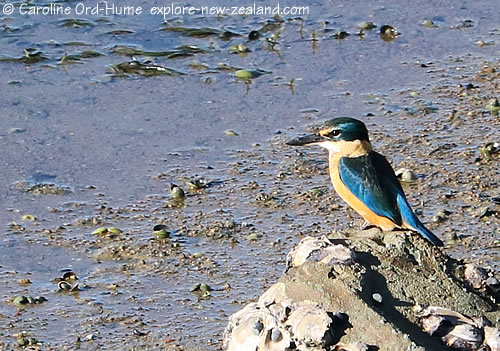
Sacred Kingfisher Species
todiramphus sancta vagans
Out of eight subspecies, the New Zealand subspecies is vagans.
Other names used for Sacred Kingfisher are; New Zealand kingfisher, kōtare, kotare, tree kingfisher, wood kingfisher, green kingfisher.
Although Sacred Kingfisher can also be found in Australia and Western Pacific, the Maori name of kōtare was given to the subspecies that is only found in New Zealand.
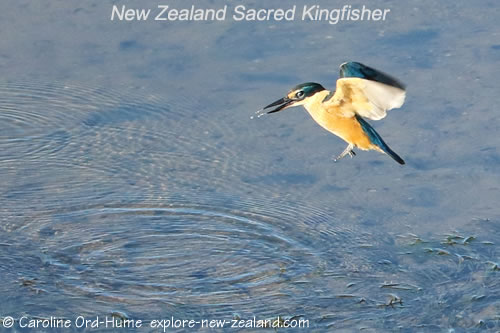
Habitat of Sacred Kingfisher
New Zealand has a wide range of habitats to suit Kingfisher birds. Some of the main characteristics of preferred feeding and breeding locations for Kingfisher are; observation posts that are elevated from which they can hunt such as branches and power lines, trees and banks into which they can excavate to build their nests, and relatively open habitats supporting the range of prey they hunt such as mud flats, estuaries, rocky coastlines, river banks, lakes, wetlands, mangroves, forests, and farm lands.
The Sacred Kingfisher is a very shy bird and difficult to approach for taking a good photograph. You can watch them from a distance if you stand still but if you want to get closer for good action photography you will have to have plenty of patience and sit extremely still for them to get used to you being there and carry on with their hunting. If they see movement they will quickly disappear out of range!
Geographic Distribution of Sacred Kingfisher in New Zealand
Sacred Kingfisher can be found on the North Island, South Island, and Stewart Island, along with the Kermadec Islands. They sometimes visit the Chatham Islands but do not inhabit the sub Antarctic islands.
There tends to be more Kingfishers in the North Island than the South Island and although they can be seen in both coastal and inland habitats, salt and freshwater, they are not common in mountainous regions or in the centre of the islands.
New Zealand Sacred Kingfisher Colours and Identification
New Zealand Kingfisher are very distinctive with green blue feathers on the back and cap, yellow / orange to buff colour under body, a black bill that can look too large for the bird, and a black eye stripe. Females and juveniles are duller in colour than males, and the juveniles can display a brown mottling in the chest and collar until they mature.
I thought that some Kingfisher looked rather scruffy with their under colour feathers often looking dull and dirty, I put this down to them getting crabs from muddy estuaries!
The flight of Kingfisher is also very distinctive with rapid beats of their wings, fast gliding, and speed and directness of aim to their destination. Most times they will fly at speed with accuracy to their prey, and then return to their elevated perch from which they can look for more prey, or to the nest to feed their young.
For the New Zealand Sacred Kingfisher, it is the green-blue back and cap colouring, along with the thick black bill that distinguishes it from other species.
Sacred Kingfisher Food
Kingfishers have been observed diving for prey up to 1 metre depth into water. In the mud flats of an estuary small crabs make up their main prey. In freshwater they will take small fish, tadpoles, and freshwater crayfish. In open farmland or countryside they will hunt for a wide range of insects such as stick insects, weta, beetles, and cicadas, along with small lizards, mice, and even small birds.
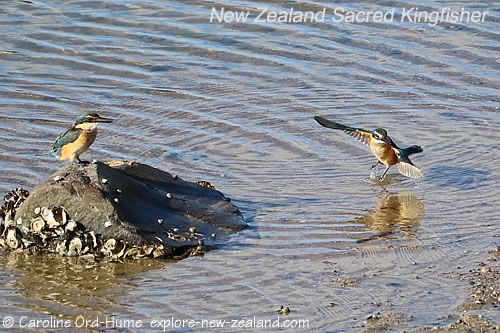
Sacred Kingfisher Survival and Conservation in NZ
The Kingfisher population in New Zealand is one of the few bird species that has actually benefitted from deforestation resulting in an increase in the habitat they enjoy, the edge of forests. They have also profited from human made structures that provide places on which they can perch and hunt from, such as fencing and powerlines, particularly around estuary environments.
Kingfishers have been persecuted in the past for being a threat to fish such as goldfish and trout, and also to bees. One threat to Kingfisher is cats, just as they are to the majority of birds. However, cats and dogs beware as the Kingfisher can attack and blind such animals if they are felt as a threat.
Sacred Kingfisher is not considered to be a bird species under threat in New Zealand.
New Zealand Sacred Kingfisher in Flight, Hunting for Crabs in Mud
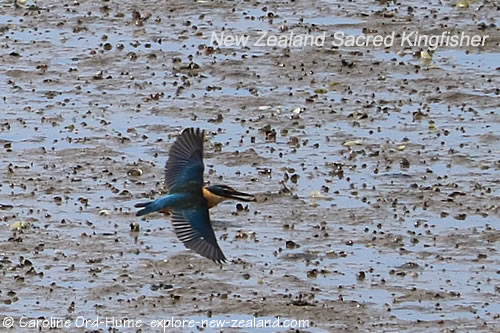
New Zealand Birds and Wildlife
List of New Zealand Native Birds and List of New Zealand Animals, Land and Marine
